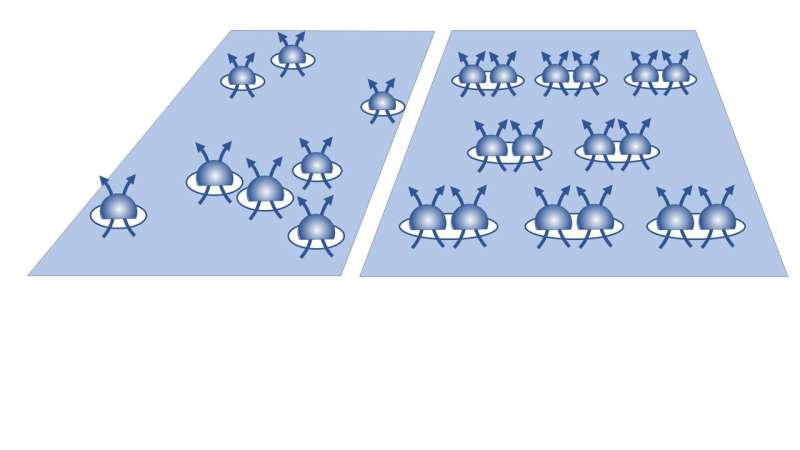
Strong interactions between particles in physical systems can result in various highly correlated ground states. These states and the strong correlations underpinning them have been extensively explored in recent years.
Researchers at Purdue University, Monmouth College and Princeton University have recently observed a highly correlated state in composite fermions, particles that emerge from the binding of electrons and vortices. The state they observed, outlined in Nature Physics, is known as a "bubble phase," as it is marked by the clustering of composite fermions into a bubble.
"Experimentalists are thrilled to find anomalies in their data," Gábor A. Csáthy, one of the researchers who carried out the study, told Phys.org. "Years ago, with my former postdoc Ashwani Kumar, now an Associate Professor at Monmouth College in Illinois, we found some unexplained features in our data on a very special high mobility two-dimensional electron gas grown in Dr. Loren Pfeiffer's lab at Princeton University. I remember we got excited, but we brushed off the explanation as a trivial but well-known effect."
An anomaly similar to the one initially observed by the researchers was later observed during a study conducted by graduate students Vidhi Shingla and Haoyun Huang under Csáthy's supervision. Initially, the team suggested that this anomaly might reflect a trivial spin transition, yet this hypothesis was ruled out by later studies. Ultimately, they found that the anomaly might be linked to a new topological ground state.
"Topological physics permeates contemporary condensed matter, atomic and molecular optics, and other subfield of physics," Csáthy explained. "Electronic correlations are in general recognized to lead to novel topological states, but the nature of these topological phases is not always well understood. There were some very interesting predictions of certain higher order topological phases called composite fermion bubble phases by groups of Jainendra Jain at the Pennsylvania State University and of Cristiane Morais Smith at Fribourg and Utrecht University, but signatures of these phases have not been observed."
Using transport measurements, Csáthy and his colleagues detected the localization signature of a bubble phase of composite fermions. Composite fermions, which are formed by electrons capturing two magnetic flux quanta and carrying a fraction of the elementary charge, were previously well-documented in the fractional quantum Hall regime. Generally, these composite fermions are randomly localized, due to the ubiquitous disorder present in experimental samples.
"The typically low density of these composite fermions is not conducive to their interaction," Csáthy said. "However, when the interaction between the composite fermions overcomes disorder effects, composite fermions were predicted to cluster into bubbles of composite fermions. These bubbles then order on a triangular lattice. One may think of an impractical egg carton, in which each cup holds several eggs." The high-mobility sample the group used and the low temperature environment of the experiment provided auspicious conditions for these bubble to form.
Composite fermions clustered into a bubble during this phase produce characteristic transport signatures associated with their localization, which can be detected using transport measurement tools. More specifically, the researchers found that the longitudinal magnetoresistance in their sample vanished, while the Hall resistance is quantized to a fractional value of the so-called Klitzing constant.
"We observed these signatures at large density of the composite fermions, at which the bubble phase of the composite fermions is likely to form," Csáthy said. "We found the first member of a new class of highly correlated topological phases. In a sense, we expanded to periodic table of topological phases that can be stabilized in the two-dimensional electron gas not just with a new member, but with a new period."
The recent work by this team of researchers unveils the existence of a new correlated topological phase, which could be further examined in future works. In addition, their findings could impact new experimental applications of topological phases that involve the manipulation of composite fermion excitations, or other sample excitations.
"In our next studies, we will likely explore the fundamental properties of these bubble phases," Csáthy added. "There are numerous open questions: under what experimental conditions do these bubble phases form, how to detect different types of bubble phases, why bubble phases do not form everywhere where our current intuition would predict them to be stable at. We will also try manipulating electronic interactions leading to the formation of these bubble phases."
More information: Vidhi Shingla et al, A highly correlated topological bubble phase of composite fermions, Nature Physics (2023). DOI: 10.1038/s41567-023-01939-2
© 2023 Science X Network
Citation: Researchers observe a bubble phase of composite fermions (2023, February 16) retrieved 16 February 2023 from https://ift.tt/CjmbE0o
This document is subject to copyright. Apart from any fair dealing for the purpose of private study or research, no part may be reproduced without the written permission. The content is provided for information purposes only.
https://ift.tt/GV0qzpf
Science
No comments:
Post a Comment